Few social media practices escape the arm of experiments here at Buffer. We love testing, iterating, and testing again to find ways to boost our metrics and explore new ways to interact better with our audience.
Now Google+’s turn has finally come.
We have made pushes on Twitter, Facebook, and LinkedIn to grow our numbers, and most recently we’ve been trying out some new tactics with Google+. And while doing so, we noticed that many others are talking about and testing out Google+ right alongside us.
Our dabbling, along with some expert opinions, point toward Google+ indeed being a smart place for your business to be. It is not the ghost town that others have claimed. There is real value to be gained and a wealth of different tips, new tools, and good perspectives to apply.
How Google+ differs from Facebook
When critics decry Google+, they often do so from a tough perspective: Google+ compared to Facebook.
That’s a hard comparison to make, for Google+ or any other social network. Facebook is far and away the most popular social media site in terms of users and usage. When looking at the raw numbers, Facebook would make most anyone look like a ghost town.
A better way to judge Google+’s value is in comparing it to the other social networks. Here, the outlook brightens. By many counts, Google+ is even with Twitter as the No. 2 social network. And there is positive growth for Google+ compared to some others.
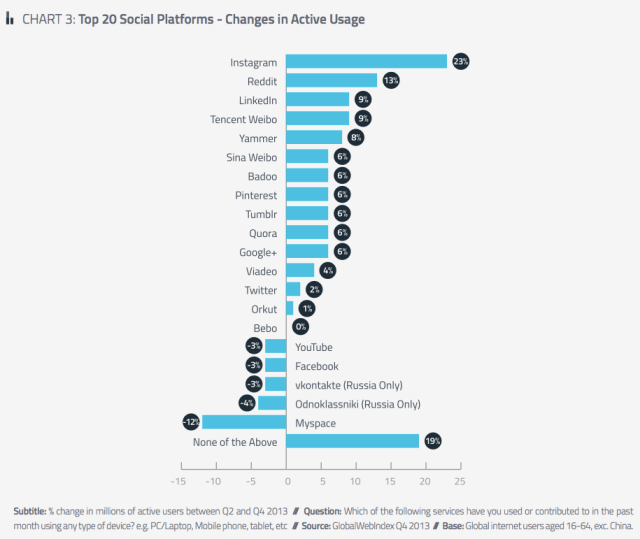
More so than raw numbers even, there are distinct differences in the ways that people use these networks.
Michael Stelzner of Social Media Examiner puts the difference this way:
Google+ is more of an interest-based network, whereas Facebook is the place where people connect with others they already know.No wonder the two networks feel so different.
There is one stat that shows a level playing field (and it’s a good stat): engagement percentage. A 2014 Forrester research study of over 2,500 posts by brands on Facebook, Google+, and Twitter showed that the gap in engagement is quite narrow between Facebook and Google+ (with Twitter a distant third).
Engagement percentage, in the Forrester study, was measured by total interactions divided by total number of followers/fans of the brand.
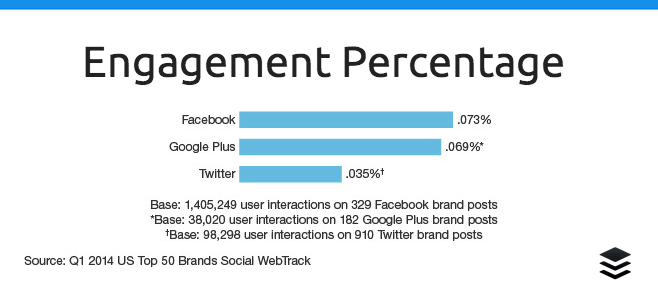
With this in mind, let’s explore the 13 most helpful features and best practices for Google+ pages, based on our own learnings and those of our fellow Google+ experimenters.
1. Post up to 5x times per day without losing engagement
While researching about the best frequency to post on social media, we didn’t turn up much data on Google+. So we thought we’d try to create some ourselves.
Our social media audits have shown that Google+ has been a growing segment for engagement with our fans. We get twice the engagement on Google+ than we do on Facebook.
We noticed this trend when posting twice per day. Would the engagement rise even more if we started posting five times?
We changed our twice-per-day schedule to five times per day and have been consistent with this for the past three weeks.
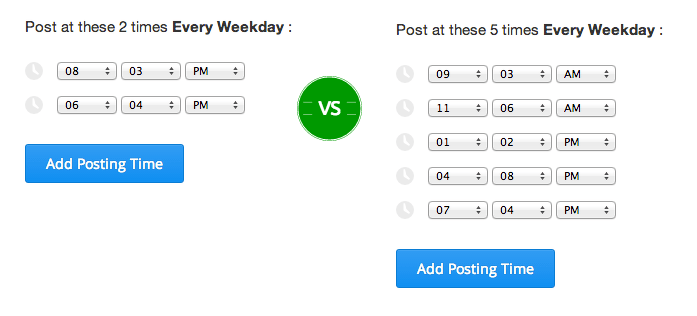
Here are the results:
When measuring engagement per post, we noticed that comments, clicks, reshares, and plus ones were all higher when we were posting only twice per day.
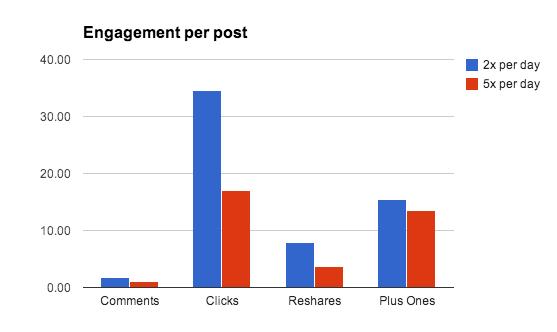
This might have led us to believe that posting less often was the better option. But there was another way to look at the data, too. Rather than engagement per post, we ran the numbers based on engagement per day. The theory here is that if we can drive more clicks, plus ones, reshares, and comments on a daily basis, then posting more would be worth it (even if individual post engagement goes down).
Sure enough, the numbers flipped. In every instance—comments, clicks, reshares, and plus ones—our engagement per day was higher when we posted five times.
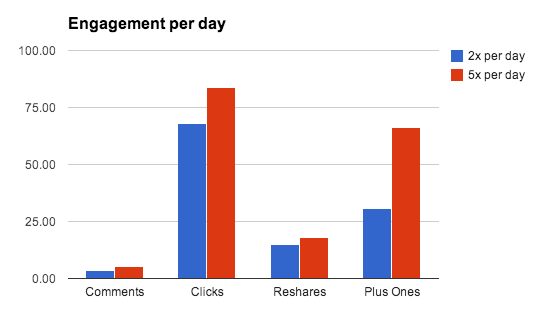
The takeaway here is to not be afraid to post more often to Google+. So long as the posts remain high-quality, immersive, and valuable to your audience, you should continue to see your engagement numbers rise.
2. Always start with a headline
Google+ posts are unique in a lot of ways, and one of those is that they act more like mini blog posts. You have room to say more, to write in paragraphs, and to use extensive formatting to really sell your content.
And what do all blog posts have in common? A good headline.
Designwise, a headline can help your post stand out, especially if you use Google+ markup to make the text bold (add an asterisk before and after the text you want bold). In addition to the visual benefit, there are also SEO benefits for doing this. Cyrus Shephard explains:
- Google incorporates your headline into the title tag of the Google+ post
- The headline is typically what displays in Google search results for Google+ posts

Adding the right headline can help your post stand out in search results, and can greatly influence the number of people who both notice and click through to your content.
3. Share the most popular content at the best times
Neil Patel of Quick Sprout collected data from a number of different studies to come up with the most important factors in growing a Google+ page. His conclusions covered everything from authorship to asking questions, along with some solid recommendations on the best type of content to post and when.
Videos – by sharing videos related to your business, you can roughly get 28.6% more engagement.
Post on Friday – there are a lot of people on Google+ on Fridays from 11 am to 2 pm.
All the data was compiled into an incredibly detailed infographic, which is well worth the visit over to his site to see in full.
He found that there are five different types of content that are preferred by Google+ users: Video, animated GIFs, Quotes, questions, and images. Of these, animated GIFs are the content that drives the most +1s. (And perhaps not surprisingly, questions drive the most comments.)
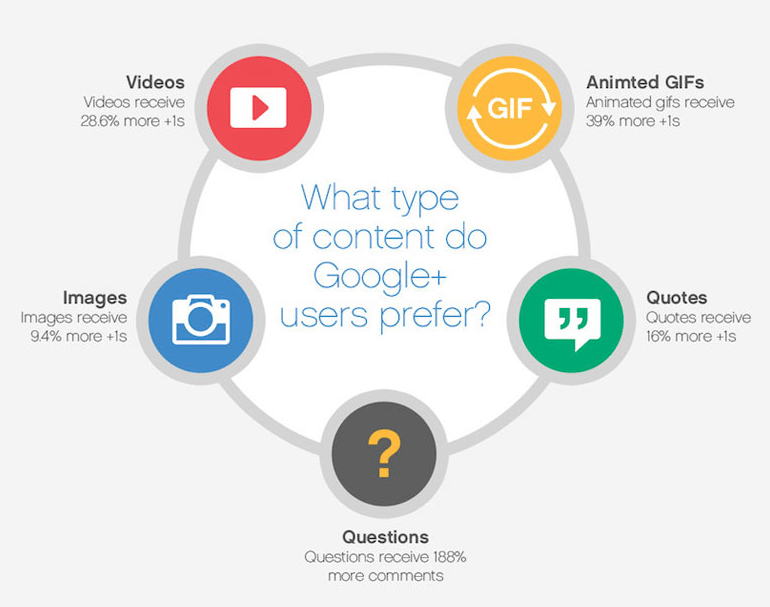
4. Enthusiasm, and the anatomy of an awesome post
Dejan SEO put together a comprehensive study of why certain posts of theirs performed better on Google+ than others. One of their key takeaways was that enthusiasm in the way you compose the update had a strong effect on a post’s popularity.
Posts in which I show enthusiasm and excitement tends to do better. Examples: YES! Finally! WOW! OMG! Whoa! …
Being interesting alone is not enough in most cases as many potentially viral posts simply die out in its infancy while other, more influential channels may hit the critical mass instead.
The following were some additional factors that seemed to correlate to success:
- Breaking news
- Content demand
- Image use
- Simple message
- Optimal post time
- Influencers triggered (reshares, +1’s)
- Community impact

5. Take your blog comments to Google+ (or vice versa)
Copyblogger made a splash recently when they announced that they were getting rid of comments. Or, rather, they were taking comments elsewhere—Google+, for one.
We’re fortunate enough (mainly because Copyblogger’s been around for so long now) that we have a lot of thriving “outposts” where conversation happens, particularly Google+ and Twitter.
Copyblogger’s blog posts now end with a call to action that reflects this change-of-address for conversations. (Note the awesome distinction they made. The conversation is not being taken “elsewhere;” it’s being taken “further.”)

Of course, a major change like this will not be in the best interests of many blogs. So rather than getting rid of comments altogether, you could encourage follow-up comments at Google+ in addition to the many other ways (comments section included) that your readers can get in touch.
Then there’s the flip side: You could bring Google+ into your comments.
Similar to Facebook’s commenting plugin (which you’ve likely seen in use around the ‘Net), Google+ has a comment system with many of the same features. The Google+ commenting system is officially supported on Blogger.com, but if you run a WordPress blog, there are plugins that can help make the integration easy.
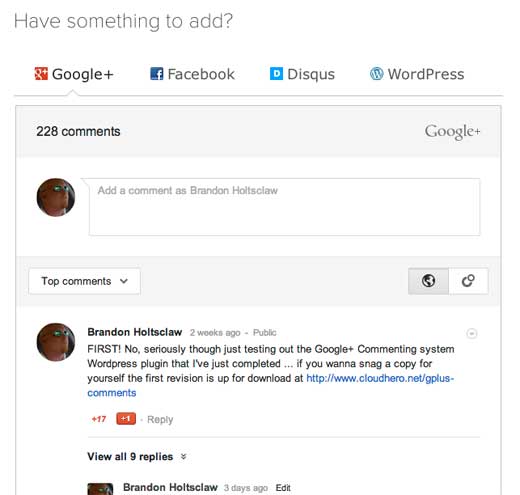
6. Embed your Google+ posts directly on your site
I’ve embedded a tweet. I’ve embedded a Facebook post. But never anything from Google+. That this functionality is right there under our noses is a great find for those who are interested in integrating their Google+ content with their website or blog. Even better, embedded Google+ posts include the comments and conversation along with the actual post.
The actually embedding process is a little more complicated than what you’ll find on Twitter. To embed your Google+ posts, click the arrow in the upper-right corner of any post Choose “Embed post” from the drop down menu.
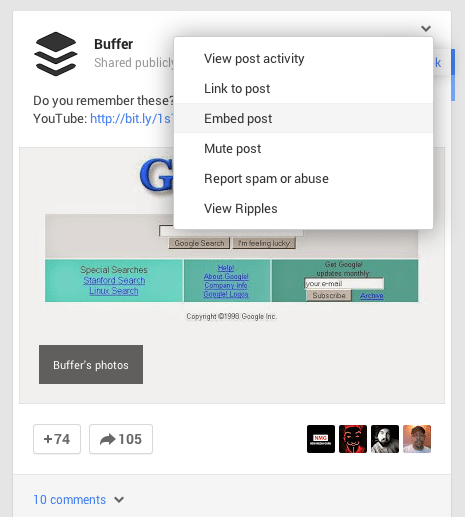
The embed code you will be given comes in two parts. The first is a script tag that needs to be placed in your HTML template, and the second is the actual embed information for the post, which can be placed anywhere.
Julie Niedlinger at CoSchedule has a lot of really neat ways to use this embed feature. One of my favorites: Create a circle of customers/influencers/favorite apps/etc. and share this to your Google+ page as a post. Then share again as an embed on your blog or website.
7. Make good use of Google+ hashtags
This advice is going to be super easy to follow. Google+ automatically adds related hashtags for you based on your content.
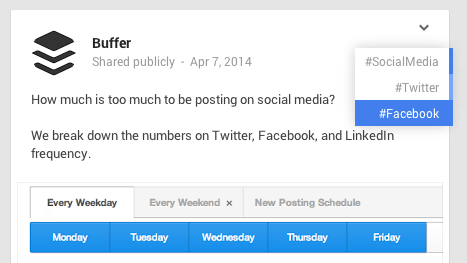
You can still supplement these tags with hashtags of your own, either placed directly into the text you write or at the bottom of the post after your main text (see below). In both cases, the hashtags are added to the side menu on the post and highlighted in gray; the hashtags that Google+ automatically adds are highlighted in blue.
Best practice for hashtags on social media is between two and five hashtags per post. With Google+, it may be best to aim for a maximum of three or four since hashtags are automatically set to a bold font and overuse could distract from your content/visuals. Also, keep an eye on trending hashtags (viewable from the explore tab) for extra opportunities for engagement.


8. Connect your YouTube channel with your Google+ page
Pretty much every Google product these days has a way to integrate with Google+. YouTube is no exception. You can connect your YouTube channel and Google+ business page, making it easy for fans and followers to jump from one to the other.
Among the benefits of a verified YouTube-Google+ connection is that you can quickly view YouTube analytics right from your Google+ dashboard. It’s not an in-depth look by any means, but it does show key metrics for views, minutes watched, and new subscriptions. It could save you a few clicks when all you need is a quick glance at the pulse of your channel.
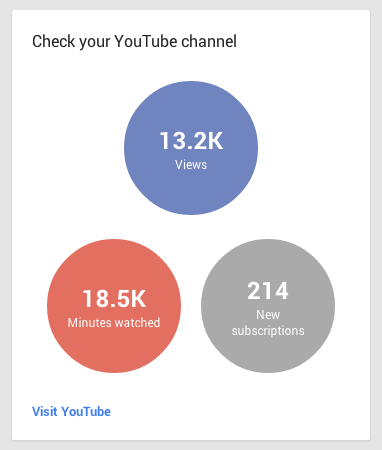
9. Create a community and use circles creatively
I’ll be honest: Google+ circles confused me at first. As I’ve got to know them better, though, I can see the real value they have for community building, sharing, and connecting. With Circles, Google+ has an added opportunity for brands to interact with a specific set of users, along with the more standard community groups. What’s the difference between the two?
- Think of Circles as a curated list. You decide who gets added.
- Communities are more like traditional social media groups. You start a community on a niche topic, and others join and contribute.
When you join communities and create circles, you can then tailor the updates you send and share directly with specific groups. For instance, you could share privately with a single user, you could share with a list of top followers, or you could share to an industry-specific group.
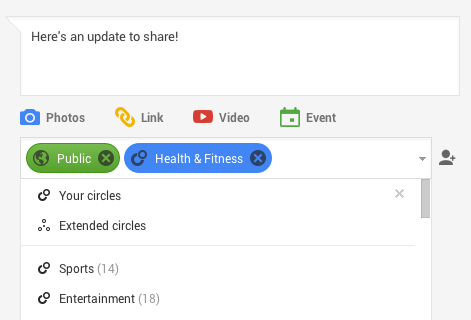
Like any other area of social media, these communities are hugely important in terms of interaction and relationship-building. There is value in digging into these places daily, posting your most relevant and well-timed information, and being available to comment and give back to the conversation.
10. Share straight from Google Drive
Might you have some golden content hidden in your Google Drive? We are quite fond of transparency here at Buffer, so the thought of sharing some of our behind-the-scenes files is exciting. We’ve done this before with our open salaries spreadsheet. You may be able to find similar ways to share interesting forms, surveys, spreadsheets, how-to documents, and presentations.
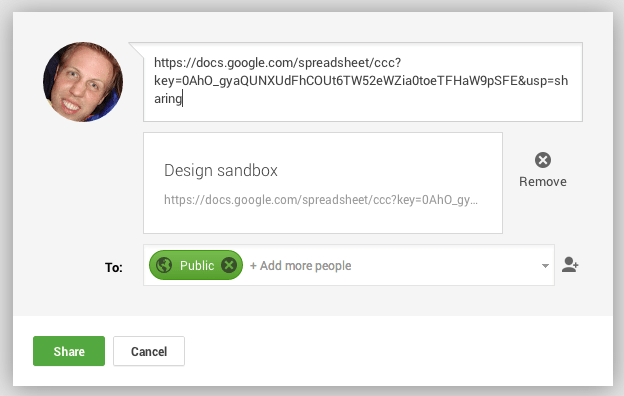
Google explains a couple different ways to do this. You can share a public document by copying and pasting the link into a Google+ post (like in the screenshot above). Or you can share directly from within Google Drive by clicking on the blue “Share” button in the top right corner.
11. Try your hand at +Post ads
If you’re interested in a new layer of advertising beyond Google Adwords, you can try the +Post ads from Google, which turn your Google+ posts into display ads that run on Google’s ad network.
The network serves over 2 million websites, so it’s possible to get a huge number of impressions. Also, pay-per-click is replaced with pay-per-engagement, so you may find better value for your ad dollar. The example cited by Google is a campaign by Toyota that achieved 50 percent higher engagement rate with +Post ads than the industry average for typical rich media ads.
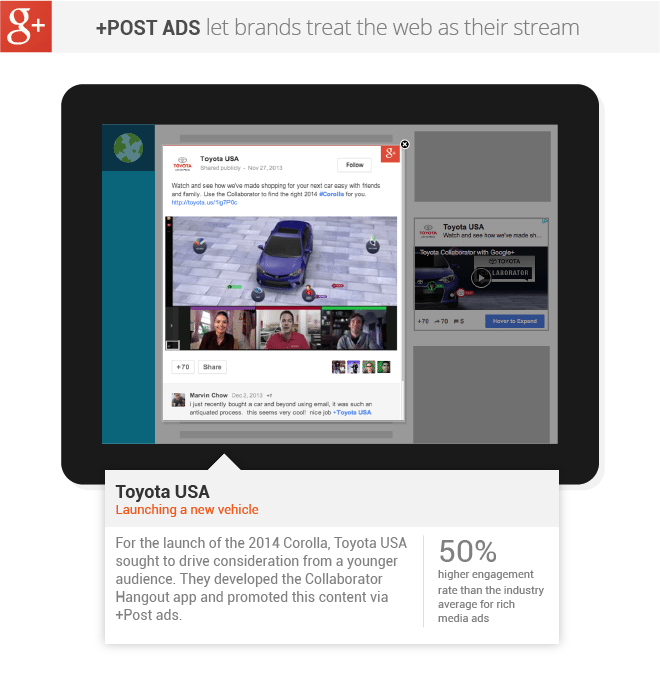
12. Encourage your writers to set up Google authorship
“Encourage” probably isn’t a strong enough word here. Your content creators need to have their Google authorship in place so that your content gets all the added juice from rich snippets, SEO, and the many other factors that make authorship so essential.
For authors, growing your reach on Google+ is important so you can build your follower count, which is pictured along with your image and other info right in the search results page. More followers, more social proof, and (it would stand to reason) more clickthroughs.

13. Try live video with Hangouts on Air
Google Hangouts are one of the most-loved features of Google+, and the live versions—Hangouts on Air—have a lot of neat applications for social media marketers. Hangouts on Air allow for all the features you might need in a live presentation: multiple hosts, slides and visuals, and tools to engage with the live audience whenever and however you’d like. And when it’s all over, the Hangout integration with YouTube means you have an archived replay ready to use and share as new content.
We have recently been dipping our toes into them here at Buffer, using them for customer interviews and webinars. (By the way, we’re
hosting a webinar Hangout on Air with the Twitter team this Wednesday, April 30.Takeaways
When it comes to finding time to handle all your various social media marketing, we’re all a little pressed. The potential benefits of Google+ (not to mention all the cool tools) should hopefully have you at least considering how it might fit in your plan. Here are the top tips, at-a-glance:
- Don’t be afraid to post more often—even up to 5x per day
- Use a bolded headline in every post
- Share a GIF, videos, photo, quote, or question on Friday afternoon
- Add enthusiasm to your update
If you want to start somewhere, the above advice is as good a place as anyone. We’ll definitely keep you updated on how this all goes for us, too.
What has been your experience so far on Google+? Do you have a business page? If so, have you tried any of the above tips and tools? I’d be real interested to hear what you have to say.
P.S. If you liked this post, you might also like Why Google Authorship Is So Important for the Content You Create and Buffer for Google+: The Easiest Way to Post to Your Google+ Business Page.
Image credits: Michelle Brea, TechCrunch, Forrester, wpbeginner, Moz, Google, DeJean SEO,
Try Buffer for free
190,000+ creators, small businesses, and marketers use Buffer to grow their audiences every month.



